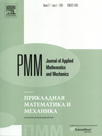 | | Journal of Applied
Mathematics and Mechanics
Russian Academy of Sciences | | Founded
in January 1936
(Translated from 1958)
Issued 6 times a year
ISSN 0021-8928
(print version) |
Archive of Issues
| Total articles in the database: | | 10610 |
| In Russian (ΟΜΜ): | | 9811
|
| In English (J. Appl. Math. Mech.): | | 799 |
|
| << Previous article | Volume 76, Issue 4 / 2012 | Next article >> |
| P.O. Bulanchuk and A.G. Petrov, "The vibrational energy and control of pendulum systems," J. Appl. Math. Mech. 76 (4), 396-404 (2012) |
| Year |
2012 |
Volume |
76 |
Issue |
4 |
Pages |
396-404 |
| Title |
The vibrational energy and control of pendulum systems |
| Author(s) |
P.O. Bulanchuk (Moscow, Russia, bullpav@yandex.ru)
A.G. Petrov (Moscow, Russia) |
| Abstract |
The motion of a pendulum system with a finite number of degrees of freedom under the action of vibration, the frequency of which considerably exceeds the frequency of natural oscillations of the system, is considered. For the averaged motion, the effect of vibration leads to the occurrence of an additional term of the potential energy (the vibrational energy). A general expression for the vibrational energy is derived using canonical averaging of Hamilton's equations. Stable steady motion corresponds to a minimum of the effective potential energy. The general problem of determining the vibration parameters of the suspension point, for which periodic motions exist in the neighbourhood of a specified position of the pendulum system, is formulated. Its analytical solution is constructed from the condition for a minimum of the effective potential energy. It is shown that, for high-frequency vibrations of the suspension point, steady motion of a point mass of the pendulum is established, in which its velocity in the principal approximation is directed along the pendulum rod. The direction and amplitude of the vibrations of the suspension point, corresponding to equilibrium and stability, is determined for any specified position of the pendulum. |
| Received |
16 September 2011 |
| Link to Fulltext |
|
| << Previous article | Volume 76, Issue 4 / 2012 | Next article >> |
|
 If you find a misprint on a webpage, please help us correct it promptly - just highlight and press Ctrl+Enter If you find a misprint on a webpage, please help us correct it promptly - just highlight and press Ctrl+Enter
|
|

 Russian
Russian  English
English